Algae Quest
 July 25, 2012
July 25, 2012

Crinoids on sponges
Who cares about algae? Jeffrey Low does! And you should too! Algae provides food and shelter to many creatures on the reef. A famous and favorite amongst them is the Sargassum frogfish. Sargassum is a kind of marcoalgae, or seaweed. Some species of sargassum spend their entire lives drifting in the open ocean, never attaching to the seafloor throughout their life cycle! Kind of like flying fish! Can you think of other reef organisms that spend their entire lives in the open ocean?
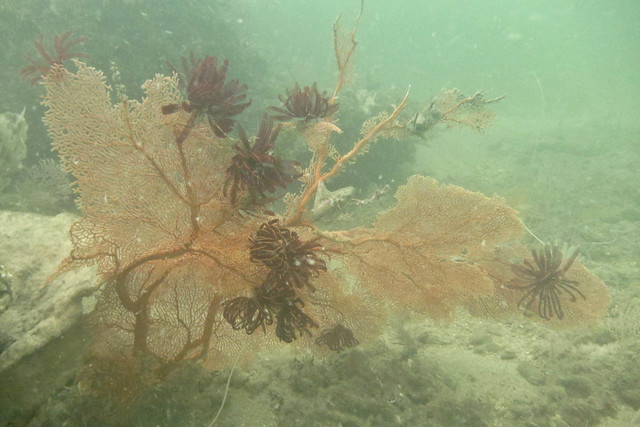
Crinoids on seafan
The Hantu Blog joined Jeffrey Low on his field trips to Sisters Island and Raffles Lighthouse to land him a hand, as well as to learn more about his work, so we can understand more about the different parts of our reefs that make it such a wonderful and interesting place! The first thing that struck me when we made our first descent into the waters off Sisters Island, was the tremendous numbers of crinoids, hung all over the seafans, seawhips, and some were even crawling about on the floor!
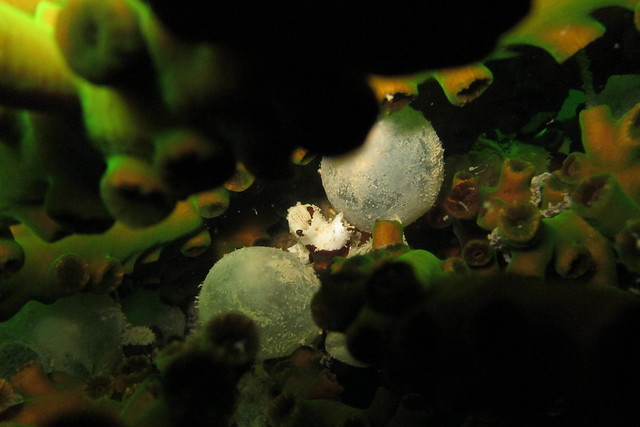
Cuttlefish eggs in cave coral colony
Clam biologist Neo Meilin also joined us because she wanted to survey the area. She pointed out these cuttlefish eggs tucked deep within a huge Cave coral colony. She even found an egg case, with skin so translucent she could see the little baby cuttlefish within it. Some of the egg cases were already empty, which means there are probably baby cuttelfish swimming about nearby!

Yellow-barred sandperch
There weren’t many fish on the reef today. We all wondered why. Was it because of the warm waters? Was it the time of day? There are so many nuances we were not aware of, and so little that we know. Which is why we have to go out as often as we can, and visit the reefs in different weather and seasons. Even with all these efforts, we’ll never know for sure what is really happening, but at least we can make better guesses.

Phyllidia seaslugs
There were also a few sea slugs dotted about the reef. Mostly Phyllidia.
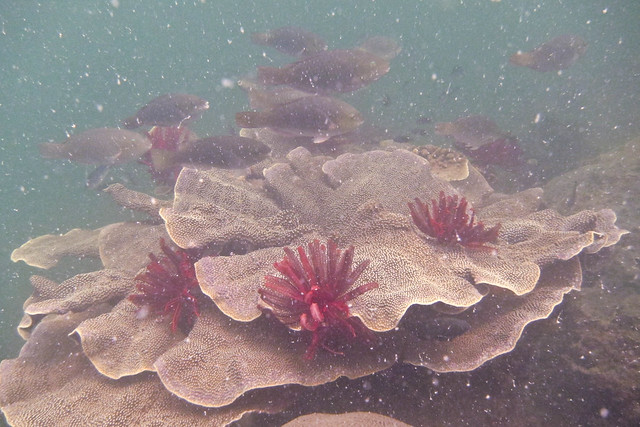
School of female parrotfish over a colony of Serpent coral decked with crinoids
We wrapped up the dive at Sisters Island with this school of female (Bleekers?) parrotfish feeding in the “snow”. As you can tell, the visibility wasn’t great, with all these little particles floating about in the water, but from the surface, Meilin and I observed a young fish feeding fervently on these white floaty bits. So while it doesn’t look very appealing to us people mucking about in the water, it appears to intertest the fish quite a bit. It’s always such a special experience to have close encounters with fish that are just going about their own business, in this case feeding.

Data loggers
This is what Jeffrey’s data loggers look like when they are fixed up on the reef. With the information collected from these little computers mounted on the reef, we can hopefully learn more about the factors that are influencing the growth (and decay) of reef organisms.

Jeffrey Low and Neo Meilin sort the samples of algae
As soon as we got back on the boat, Jeffrey and Meilin quickly got to sorting out the samples of algae taken from the reef. Jeffrey is planning to take DNA samples of the algae in an attempt to determine the diversity of algae in the Singapore in relation to the region. He also has a student who’s looking into the epifauna (little critters that live on the surface) of the seaweed. While in the ziplock bags, we could already see some of these tiny organisms scuttling about in the water. That’s with the naked eye. Imagine if under a microscope!
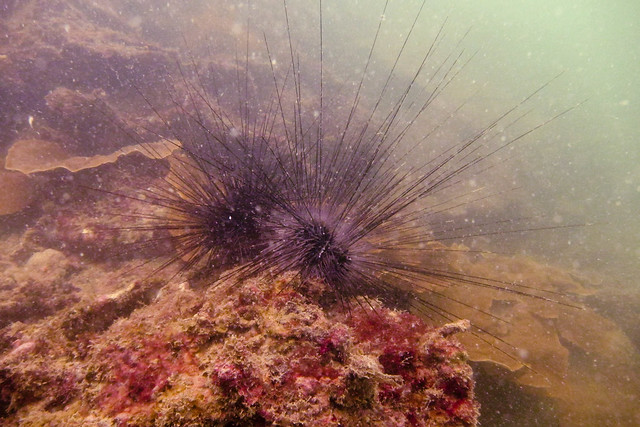
Diadema sea urchins
It’s always a wise idea to look toward the reef when you are descending! There were a whole bunch of these Diadema, or Long-spined, uchins in the shallow reefs around Raffles Lighthouse. is one of the most abundant, widespread, and ecologically important shallow water genera of tropical sea urchins.
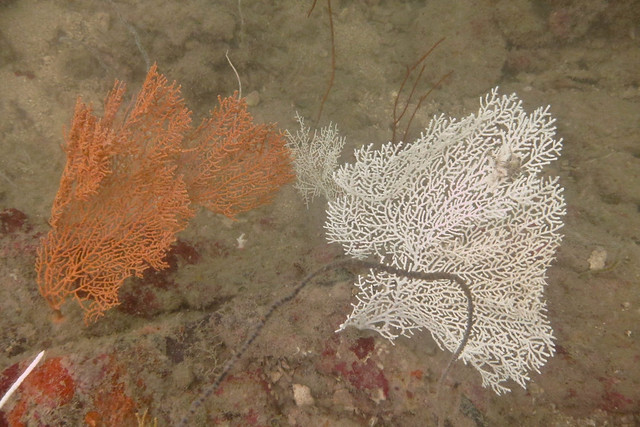
Seafans
There were more seafans at Raffles Lighthouse, though the colonies we saw today were not as large as those at Sisters Island.

Bullocki nudibranch
We squinted hard at the coral rubble, trying to find some life. We didn’t manage to find any elusive creatures, so it was a welcome relief to see a pair of Bullocki nudibranch that clearly stood out on the reef. They seemed very busy, racing across the reef.
When I saw this large whip coral sticking out of the reef, I thought I just had to find a goby living on it. And I did!
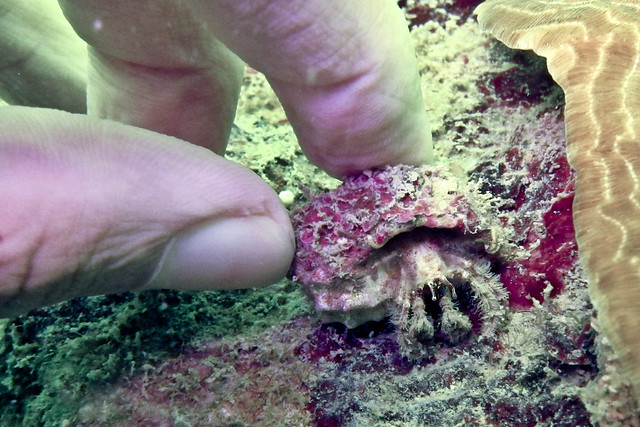
Hermit crab
Some creatures require a bit of investigation before you find anything, just like this hermit crab with its perfectly encrusted shell, that blends in perfectly with the encrusted reef!
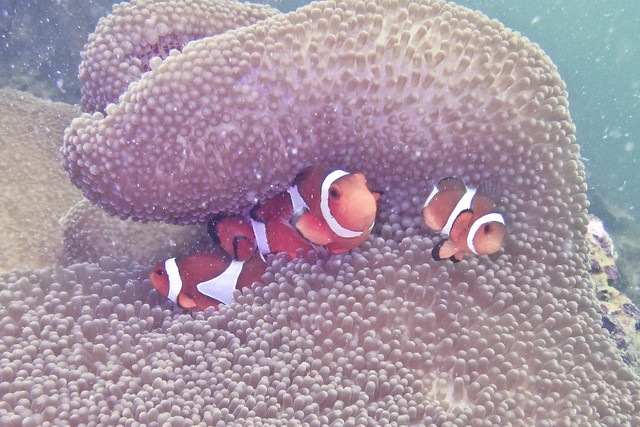
False-clown anemonefish
We came across this family of four (one more smaller member of the family was hidden under the anemone) living in a massive anemone!

False-clown anemonefish
Then we found this other gorgeous anemone with two anemonefish. This anemone was living vertically on the side of the rock. Just like the homes we live in, you can choose one that faces the sun, or faces the sea.

Mushroom coral
A part of the reef at Raffles Lighthouse had a whole bunch of Mushroom coral recruits. Perhaps some of them are still attached to the reef. I didn’t check. Eventually they will break off and be free-living corals.
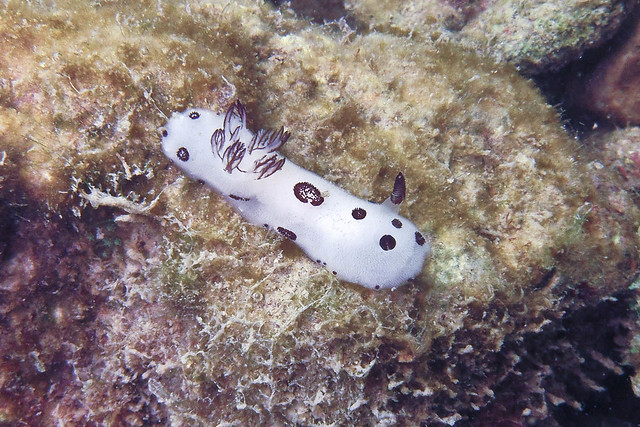
Jorunna funebris
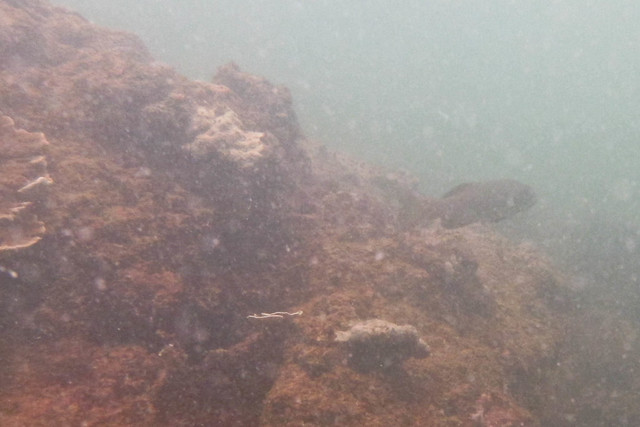
Leopard grouper
I love groupers. I saw many of them today and I was very pleased. Though they are fearsome predators on the reef, they are elusive and skittish. Rightfully so. Many a fisherman, or a larger fish, would really like to make a meal out of them. So even though I didn’t manage to get a good picture of this Leopard grouper, I’m going to share it with you anyway because it so excites me! There it is on the right of the picture, swimming away. I also saw a gorgeous Hexagon rockcod and a few Chocolate hind, all escaped my camera – bad visibility and fast/shy fish does not a picture make.

Oriental sweetlips
Here’s another photo of a fish that got away for you! This is an Oriental sweetlips. The juveniles can sometimes be seen around the reefs of Pulau Hantu and are a spectacle to watch! When they grow up, they continue to remain skittish like the groupers, because they too are a target of fishers and other, larger fish.
To check out more pictures from this dive, visit the Hantu Blog Flickr gallery.
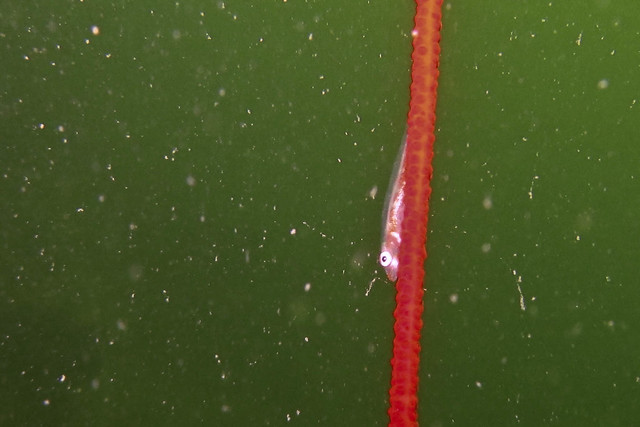
 Posted in
Posted in 



 content rss
content rss
COMMENTS